Parks Climate Challenge meets Mt. Baker's glaciers
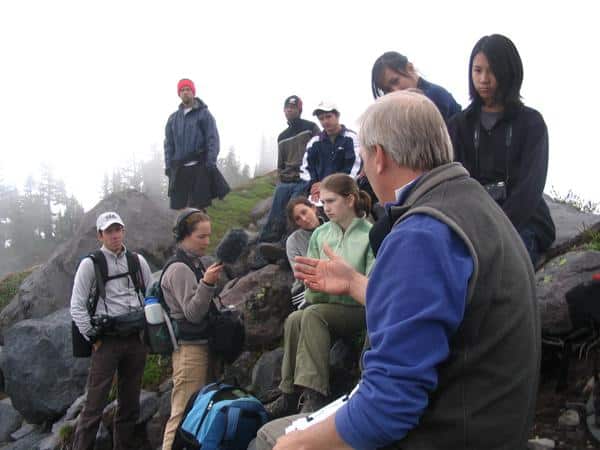
North Cascades National Park geologist Jon Riedel teaches students on a misty moraine ridge on the flanks of Mt. Baker
Elisabeth Keating, a freelance writer covering the Parks Climate Challenge, accompanied the students on their hike to a glacier on Mount Baker the second week of July 2009 and filed this report from the North Cascades.
On July 8, I arrived at the Horseshoe Cove campground at Baker Lake where the Parks Climate Challenge students were setting up camp and preparing for their glacier exploration. There are 19 high school students in this new program, each a young leader drawn from five urban areas around the country: Denver, Washington D.C., Seattle, Chicago and the Bay Area.
There are three phases to the Parks Climate Challenge: Phase 1 consists of 30 days in the North Cascades meeting with scientists, camping, exploring and learning. Phase 2 is a trip to Washington DC where students will meet with legislators and work on a service project on the Mall. For phase 3, the students will returnhome to create and lead an environmental project in their local communities. Possible projects could include planting trees, hosting a climate change day at their school or starting a recycling project at their school.
“We weren’t necessarily looking for students who are interested in careers in the environment,” explained Megan. “What’s most important is that they demonstrate leadership potential and that they return to their urban communities as ‘climate change ambassadors’ that the community will respond to.”
For most of these urban students, it’s been a process of many of “firsts”: first camping experiences, first time bathing in a stream, first time eating hummus, first time at a rodeo (the July 4th celebration in Sedro-Woolley!) and even the first time some had s’mores.
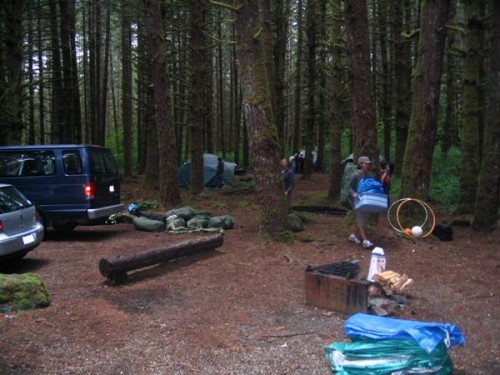 Home Sweet Home: Setting up camp at Horseshoe Cove on Baker Lake
Home Sweet Home: Setting up camp at Horseshoe Cove on Baker Lake
Everyone had fun putting up tents and cooking dinner, along with testing out the mosquito hats. “It’s not cool-looking,” one student noted, “but we don’t care as long as it gets the job done!”
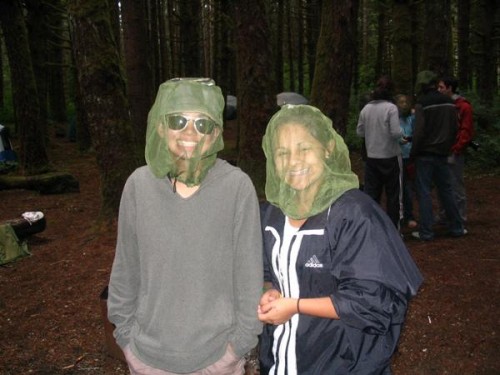 Two Parks Climate Challenge students demo their “campfire style” mosquito netting hats and sweats!
Two Parks Climate Challenge students demo their “campfire style” mosquito netting hats and sweats!
The 19 students have been living together for 10 days now, so it was time to take stock of how the group is working and living together. After dinner was cleaned up, we gathered to discuss how well the group as a whole was working and reviewed a lot of goals and core values students had made the first night. Each student anonymously wrote down what was working well and what areas could be going better, and then we sat in a circle on the lake shore, eating cookies and reading aloud everyone’s anonymous feedback.
We sat in a circle at Baker Lake and talked about the qualities of teamwork and leadership, as well as the pros and cons of group living. The consensus was that mutual respect, teamwork, and open communication was key to ensuring that the group was successful and fun.
The next morning the students split into two groups — ten went to explore alpine lake biology while the other nine headed to the Railroad Grade trail to meet with North Cascades National Park Service geologist Jon Riedel to learn about glaciers. (The next day the groups switched activities so that all the students got to have both experiences.)
I chatted with several of the students to learn what had impressed them the most about their experiences thus far.
Jane Culkin, from Denver, had never been to the North Cascades before and loves the volcanoes. “Mount Baker is breathtaking!” she exclaimed. “I’m really excited about seeing a glacier today! I’ve been looking forward to this hike all week.”
Jane is thinking her project might be to start a school composting program that connects the high school, the elementary school and the community at-large. “Denver doesn’t have a universal recycling and composting program, which is shocking. I’d like to change that. The older I’ve gotten and the more I’ve learned, the more interested I am in environmental policy.”
Laura Humes of Seattle is thinking of collaborating with fellow Seattle students Sarah Salvador and Yvonne Chen on a school-wide recycling/composting program. “I’ve wanted to do something about global warming for a while so this class was the perfect opportunity to learn and try to help. What’s been most interesting to me so far has been learning about the difference between climate and weather. Weather takes place daily, but climate change occurs over decades. We got to visit a classroom of 5th graders the other day to explain this to them which was really fun. But we still have a lot to learn this month!”
Jon Riedel, a National Park Service geologist and excellent educator, met us at the Railroad Grade trailhead up the road from Baker Lake. On the way up the mountain, he stopped to show us examples of how scientists use carbon dating to measure the age of glaciers. Jon explained that geologists study glaciers because they are very sensitive to climate change. “Climate change is natural and cyclic,” he said.
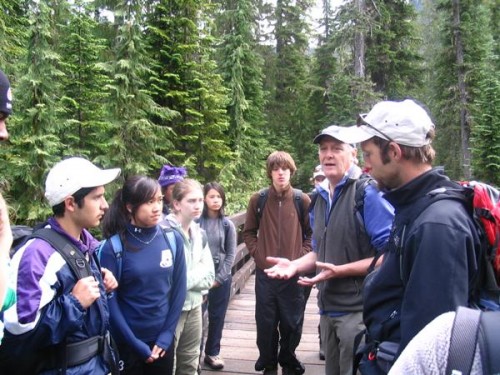 Introductions at the Railroad Grade trailhead
Introductions at the Railroad Grade trailhead
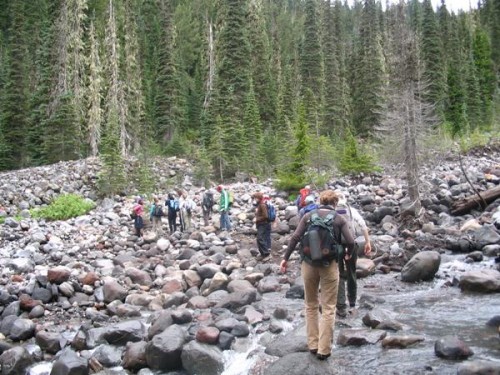 As we crossed a stream bed created by a melting glacier, Jon explained that numerous civilizations have creation myths that start with a flood… anecdotal evidence of the cyclical nature of climate change. Sea levels rose when glaciers melted, so many cultures experienced floods in ancient times.
As we crossed a stream bed created by a melting glacier, Jon explained that numerous civilizations have creation myths that start with a flood… anecdotal evidence of the cyclical nature of climate change. Sea levels rose when glaciers melted, so many cultures experienced floods in ancient times.
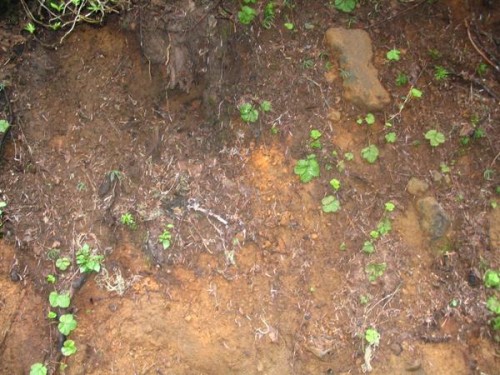 “A lot of geology is this layer cake idea,” explained Jon. “What’s below something has to be older than it.” He explained that the reddish layer of soil is a remnant from the last Ice Age.
“A lot of geology is this layer cake idea,” explained Jon. “What’s below something has to be older than it.” He explained that the reddish layer of soil is a remnant from the last Ice Age.
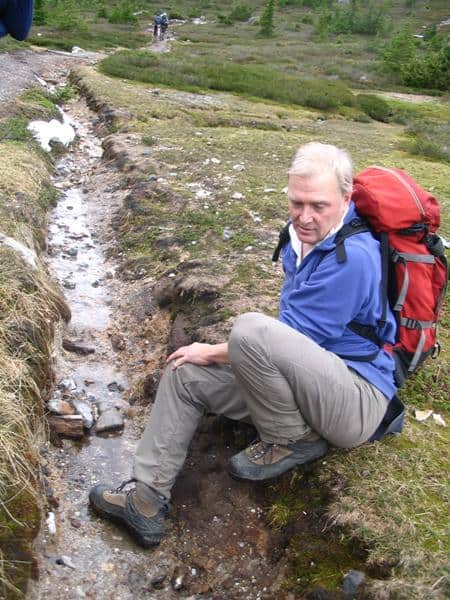 Jon shows students an 5,000+ year-old piece of wood which helped scientists establish the age of the glaciers on Mount Baker.
Jon shows students an 5,000+ year-old piece of wood which helped scientists establish the age of the glaciers on Mount Baker.
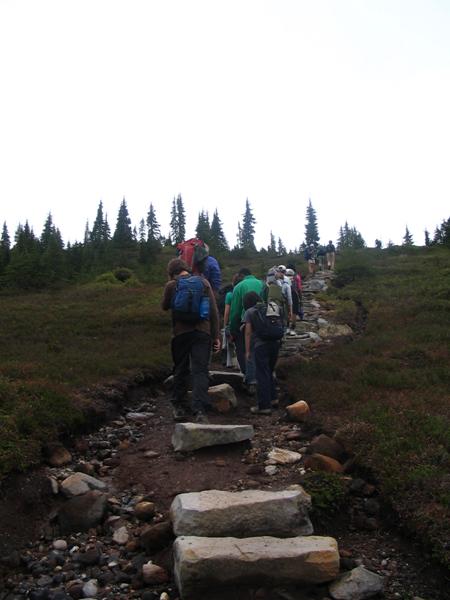 The final push to the top of Railroad Grade!
The final push to the top of Railroad Grade!
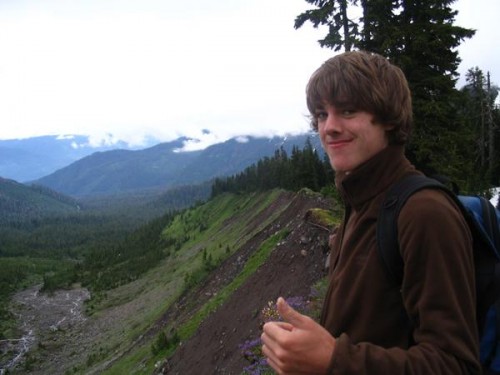 We made it to the top of the moraine! What a dramatic view. Student Colin Ridgley from the Bay Area gives the thumbs-up.
We made it to the top of the moraine! What a dramatic view. Student Colin Ridgley from the Bay Area gives the thumbs-up.
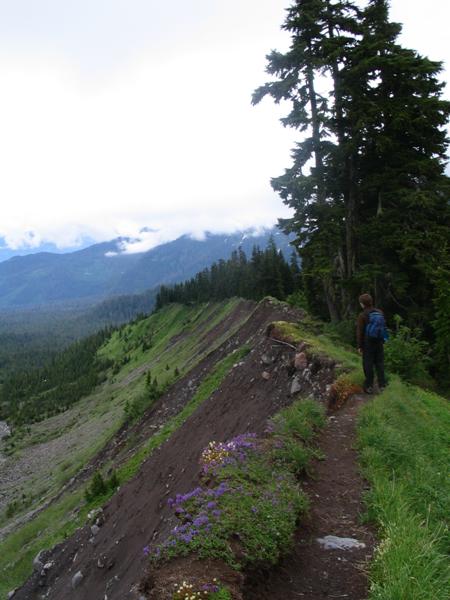 Looking down into the glacial moraine
Looking down into the glacial moraine
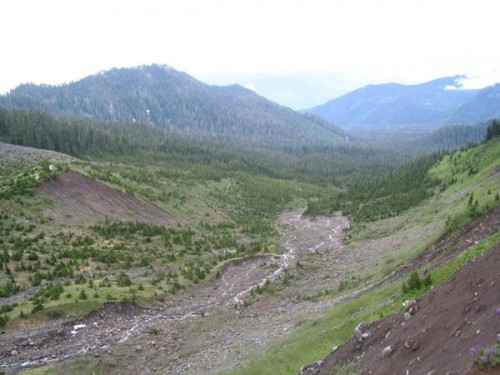 This entire moraine was filled with ice in a photo Jon showed up taken in 1917. Now the Easton Glacier has retreated dramatically in the past 100 years.
This entire moraine was filled with ice in a photo Jon showed up taken in 1917. Now the Easton Glacier has retreated dramatically in the past 100 years.
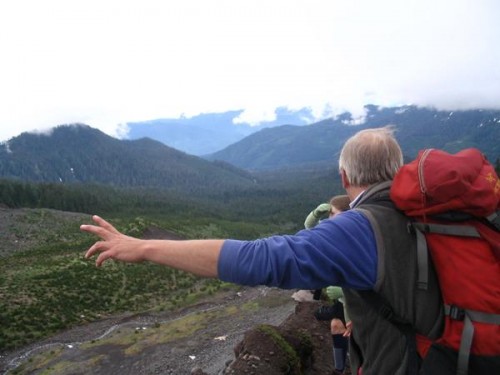 Jon indicates that the entire moraine was covered in a glacier 100 years ago.
Jon indicates that the entire moraine was covered in a glacier 100 years ago.
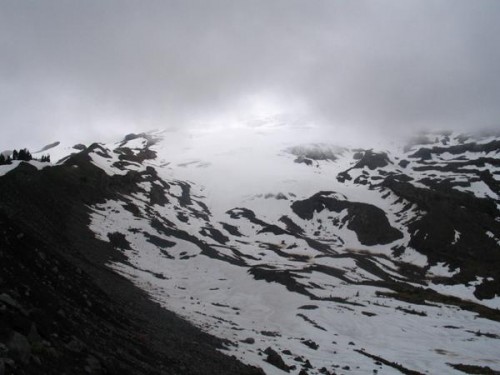 Because of the low clouds, we could only see the toe of the Easton Glacier on Mount Baker from our perch on the moraine. Seventy per cent of the glaciers in the lower 48 states are located in the North Cascades, and there are 312 glaciers in North Cascades National Park. Jon explained to us that glaciers are extremely sensitive to climate change, making them very important to study to learn about the cycles of our planet’s climate.
Because of the low clouds, we could only see the toe of the Easton Glacier on Mount Baker from our perch on the moraine. Seventy per cent of the glaciers in the lower 48 states are located in the North Cascades, and there are 312 glaciers in North Cascades National Park. Jon explained to us that glaciers are extremely sensitive to climate change, making them very important to study to learn about the cycles of our planet’s climate.
After Jon’s presentation, students asked Jon questions:
Q: What do you eat in the backcountry?
A: Frozen burritos are pretty good.
Q: Were there glaciers in Colorado?
A: Yes, there were large glacier systems in Colorado during the last ice age, but most of the glaciers found there today are rock glaciers.
Q: Do glaciers ever collide?
A: Yes but it isn’t very dramatic or exciting because they move very slowly.
Q: Will we be able to reverse the changes we see so far in my lifetime?
A: Probably not, but solutions like carbon sequestration show promise. The problem is that the changes we see in Mt. Baker’s glaciers today are ten years delayed, so we are seeing the effects of what we did ten years ago now. Smaller glaciers have shorter repsonse times than larger ones.
Jon also showed us charts that show how the Earth’s orbit and tilt of the axis affect climate change. Given the current orbit and tilt, we should be getting colder and entering an ice age. The fact that things are warming up seems clear evidence that we humans are affecting the climate. Climate is complex: it’s affected by orbit, tilt of the planet, terrain, volcanic eruptions, and changes in the ocean as well as human behavior.
On the way back off the glacier, the students talked about what they’d learned and brainstormed names for their “tribe” — one favorite was “the cool kids.” I was reminded of one of the quotations from Gandhi that students shared around the campfire the night before:
Be the change you want to see in the world.
In the coming weeks students will venture onto Ross Lake for a lesson with a cultural historian and a fish biologist, learn about old growth forests and wildfires and head up Lake Chelan to visit the wilderness outpost of Stehekin. I can’t wait to catch up with them again to hear what they’ve learned, meet more students and learn how their community projects are evolving!
–Elisabeth Keating


Thanks for the article. I learned a lot and it’s always good to at least try to stay up with your kids! Plus, it was great seeing pictures of my son because I really miss him.
Liz (Colin’s mom)
Has anyone noticed how much more bare rock is showing on Mt. Baker this year? I have never seen the mountain look like this and I have been gazing at it’s northwest side all of my life. Scary I think!!!!
Very interesting story. I want to try this hike next summer, it looks incredible. And I will feel more informed about global warming and what signs to look for as a result of reading this blog post, so thanks!